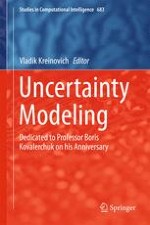2017 | OriginalPaper | Buchkapitel
A Rapid Soft Computing Approach to Dimensionality Reduction in Model Construction
verfasst von : Vesa A. Niskanen
Erschienen in: Uncertainty Modeling
Aktivieren Sie unsere intelligente Suche, um passende Fachinhalte oder Patente zu finden.
Wählen Sie Textabschnitte aus um mit Künstlicher Intelligenz passenden Patente zu finden. powered by
Markieren Sie Textabschnitte, um KI-gestützt weitere passende Inhalte zu finden. powered by
